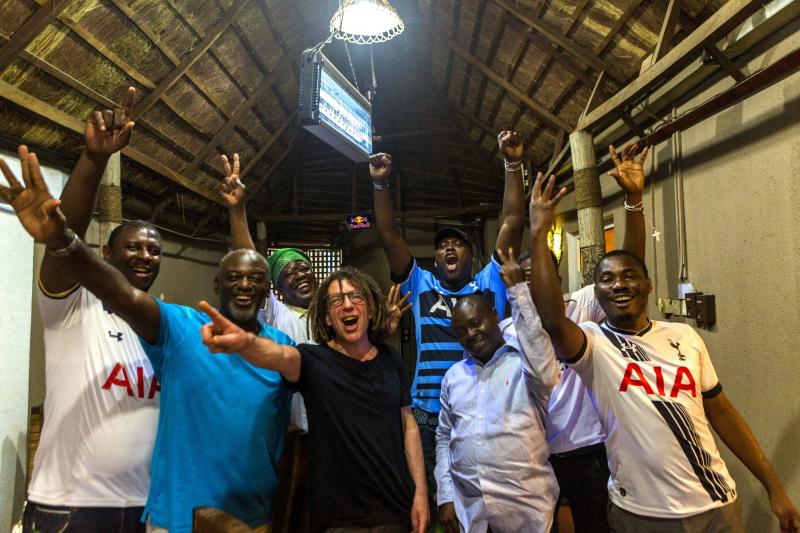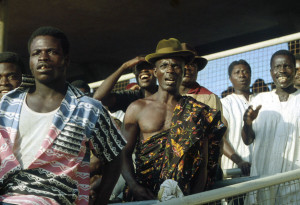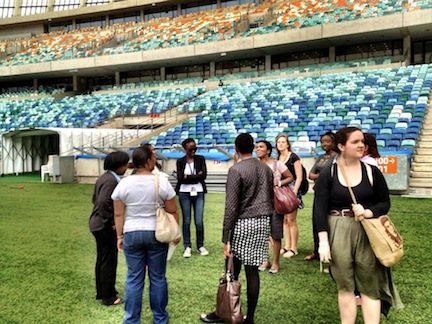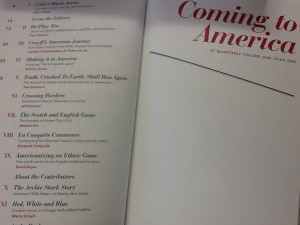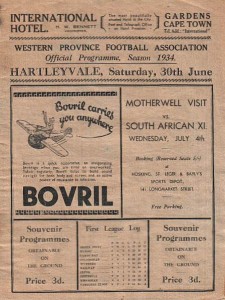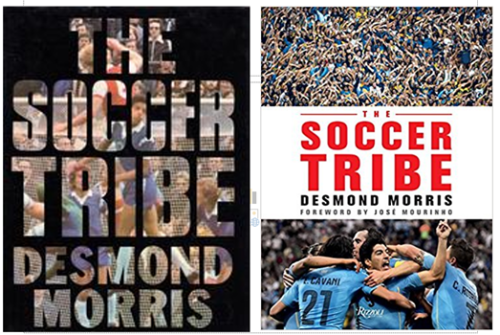
This post was originally published on Andrew Guest’s Sports and Ideas Tumbler page. It is cross-posted here with permission of the author.
I recently stumbled across a new (2016) edition of The Soccer Tribe by Desmond Morris, the peculiar tome originally published in 1981 with a mix of text and illustrations making a case for what amounts to an evolutionary socio-biology of soccer. Morris, most famous for The Naked Ape, explains that he was motivated by anthropological curiosity: “Hardly anyone seems to query the importance attached to the game. For those who do the kicking and those who watch it so avidly, the whole matter is taken for granted. Football is football, and of course it is fascinating, so what is there to question? For those who ignore it, it is plainly a stupid waste of time, so why bother with it? It is not worth discussing. Both sides overlook the fact that, viewed objectively, it is one of the strangest patterns of human behaviour to be seen in the whole of modern society.”
In seven sections and 44 chapters full of pictures, illustrations, and quirky charts, Morris then lays out an analysis of soccer in its ‘tribal’ dimensions: roots, rituals, heroes, trappings, elders, followers, and tongue. The whole thing is amazingly odd; in its scope, it compares to nothing else I’ve seen or read about soccer. In analyzing uniforms as tribal costumes, referees as tribal judges, or fan songs as tribal chants the book exhibits an imagination and ambition that I love (and have cited before here).
But since initially stumbling upon the first 1981 edition a decade ago something has always felt just a bit off about the book. It took this new edition, which seems to have been updated mostly in its illustrations (along with a few minor segments of text), to make me dig into that feeling.
The couple hundred words José Mourinho ‘wrote’ as a foreword to the new edition sets the tone: ““Total football has led to global football—on and off the field. And whoever fails to realize it doesn’t understand anything. Those who only know football know nothing about football.”
This blustering certainty is familiar from Mourinho, but it is also fundamental to the underlying premise of The Soccer Tribe – that all the patterns and rituals of modern soccer, and modern society, are a direct inheritance from humanity’s hunter-gatherer past. If Mourinho would have gone the academic route, I realized, he would have been a socio-biologist.
To be fair, Mourinho goes onto say something more interesting: “Those who only see twenty-two men chasing after a ball fail to understand its geometry, its ballet, its psychological depth, its true nature. It is the most faithful representation of human nature and its may faces. It is a tribe where the rationale of tactics, emotion, and the fun of the game all prevail.”
Though still a bit grandiose (and not overly convincing as to the question of whether Mourinho actually read the book), the basic idea of their being more to the see than ‘chasing after a ball’ is the real value of The Soccer Tribe.
The problem, however, was well articulated back in a 1983 review of the original book by Ian Taylor in the journal Theory, Culture, & Society.
What is it that is objectionable and in need of challenge in this account of association football? It is not, as we might at first think, an empirical matter (much of what is said about the origins, the present form of the game and its surrounding rituals is quite accurate and consistent with other well-respected accounts). But there are empirical silences. In the familiar fashion of most sociobiology, there is a great emphasis on football as a (naturally-evolving) form of male-bonding and, indeed, of male “warriors” (who proceed, we are told, to create homes for the “warrior mates” that are peaceful retreats from the violence and stress of the field of play”) (p 181). The account is therefore silent on the considerable growth of women’s participation in the playing of soccer In recent years, especially in North America. Again, the celebratory discussion of soccer’s present status as a world sport is couched as if some other universal and natural logic is at work. This reads very oddly in 1982, not only for the British, German and other soccer lovers worried for the future of the sport in the light of the massive reductions in attendances, but also for students of sport who have noticed the spectacular growth of a genuine plurality of spectator and participant sports in most developed countries.
The Soccer Tribe and socio-biology, in other words, present a totalizing account of human behavior that ignores the dynamism of culture. Women’s soccer is a key counter-example. If soccer is a male warrior ritual to satisfy our hunting and fighting brain modules, what to make of women’s soccer and women fans? Taylor phrases it nicely (if academically): “The empirical display of soccer as a natural form, spanning all cultures and time, masks the specificity of the game’s significance in particular social formations.”
The game itself, in the phrasing I tend to prefer, is mostly just an empty cultural form.
And, speaking of empty, the other substantive review of the original 1981 Soccer Tribe book that I could find was by the novelist Martin Amis for the London Review of Books. Amis, after a strange and extended prattling on about the English national team’s performance in qualifiers for the 1986 World Cup, dismisses Morris in two withering paragraphs, starting by noting that a soccer manager left alone with the book might “die of inanition”:
“In The Soccer Tribe Morris maps out the connection between ‘ancient blood sports’ and ‘the modern ball game’. Nowadays, the goalmouth is ‘the prey’, the ball ‘the weapon’, and the attempt to score ‘a ritual aim at a pseudo-prey’. Is this true? Or, more important, is this interesting? Morris goes on to say that ‘in England, there are four “divisions”, presenting a parody of the social class system.’ He then traces the analogies between football and religion: ‘Star players are “worshipped” by their adoring fans and looked upon as “young gods”.’ Later on, he develops a far more compelling thesis, arguing that . . .
Ah, but the sands of space are running out. That’s enough football for today. I only have time to add that Morris’s book is handsomely packaged, that the pictures are great, magic, brill etc, and that the text is an austere, an unfaltering distillation of the obvious and the obviously false.”
Amis’s point, beyond being arrogant and dismissive, seems to be that it is hard to be an intellectual interested in football—and Morris fails unreservedly.
But I think that is too harsh. The Soccer Tribe is like much socio-biology (and contemporary evolutionary psychology): simultaneously problematically reductionist and thought-provoking in a challenging way. I find it interesting, for example, that The Soccer Tribe shows up as ‘cited by’ 250 academic works in Google Scholar – though a crude marker, it is clear from browsing those citing works that the book inspired some academics to new ways to think about the game.
But it doesn’t yet seem to have inspired another similar effort–I’ve yet to see another book that takes on the totality of soccer culture in an intentional way. The 2016 ‘new edition’ ofThe Soccer Tribe thus doesn’t need much updating beyond the pictures both because the analysis freezes culture as permanently set by evolution, and because not enough of significance has come out since 1981 to offer a more dynamic theory of the game as a whole. That may no longer be the way of academic work on soccer – which has indeed done much to chip away at understanding pieces of the game – but it sure would be fun to see.

